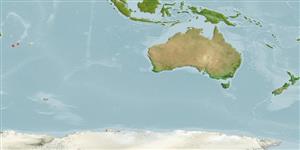Classification / Names
आम नाम | उपशब्द | Catalog of Fishes(वर्ग, प्रजाति) | ITIS | CoL | WoRMS | Cloffa
>
Blenniiformes (Blennies) >
Blenniidae (Combtooth blennies) > Salariinae
Etymology: Dodekablennos: Greek, dodeka = twelve + Greek, blennos = mucus (Ref. 45335); also, meaning "blenny"; in reference to the 12 dorsal-fin spines and pectoral-fin rays (Ref. 69212).
Eponymy: Dr Thomas Henry Fraser is an ichthyologist specialising in cardinalfish, who works at Florida Museum of Natural History, University of Florida, Gainesville and at Mote Marine Laboratory, Sarasota, Florida. [...] (Ref. 128868), visit book page.
Environment: milieu / climate zone / depth range / distribution range
पारिस्थितिकी
समुद्री ड़िमरसल; गहराई सीमा 0 - 2 m (Ref. 33390). Tropical
Western Indian Ocean: Reunion and Mauritius.
आकार / वज़न / Age
Maturity: Lm ? range ? - ? cm
Max length : 3.7 cm SL पुल्लिंग / अलिंग; (Ref. 69212)
Short description
पहचान कुंजी | आकृति विज्ञान | मौरफोमैटरिक्स
पृष्ठीय रीढ़ (सम्पूर्ण) : 12; पृष्ठीय सौफट रेज़ (सम्पूर्ण) : 19 - 20; गुदा कांटा: 2; ऐनल सौफट रेज़: 21. With 12 pectoral-fin rays; with no nape and orbital cirri; typically with fewer than 65 teeth in each jaw; with vomerine teeth; 12 dorsal-fin spines and with only 2-6 branched caudal-fin rays; terminal anal-fin ray unbound by membrane to the caudal peduncle. Males possessing a fleshy, blade-like crest on head. Color pattern based on preserved specimens: dusky head, ventrally paler with slightly dusky chevron in smaller specimens or a cross mark on the largest specimen; dusky bar continuing ventrally beginning from midventral margin of orbit across lip, posteriorly alternated by paler area from diffuse dusky bar continuing ventrally from just posterior to eye across corner of mouth to ventral surface of head, contributing to formation of dusky chevron; pale upper lip and male crest with dusky spots; lateral side of body with 7-8 dark dusky bands interspersed with pale areas; anteriormost band dorsally diffused; all bands continuing onto dorsal fin; posterior bands typically dorsally forked in males and both dorsally and ventrally in females; posteriormost band expanded in largest specimen, continuing ventroposteriorly well onto caudal fin and joining dusky stripe along ventral margin of fin; dorsal-fin spines and rays variably dusky; males with distal intensely black spots on each of the first three interradial membranes; female lacking black spots; anal fin dusky and submarginally darker; spine and ray tips without pigmentation (Ref. 69212).
Found in tide pools (Ref. 33390). Oviparous. Eggs are demersal and adhesive (Ref. 205), and are attached to the substrate via a filamentous, adhesive pad or pedestal (Ref. 94114). Larvae are planktonic, often found in shallow, coastal waters (Ref. 94114).
Life cycle and mating behavior
परिपक्व अवधि | पुनरुत्पत्ति | मछलीऔ का अंडे देना | अंडे | Fecundity | लार्वा
Oviparous, distinct pairing (Ref. 205).
Fricke, R., 1999. Fishes of the Mascarene Islands (Réunion, Mauritius, Rodriguez): an annotated checklist, with descriptions of new species. Koeltz Scientific Books, Koenigstein, Theses Zoologicae, Vol. 31:759 p. (Ref. 33390)
IUCN Red List Status (Ref. 130435: Version 2024-1)
Threat to humans
Harmless
Human uses
साधन
Special reports
Download XML
इंटरनेट स्रोत
Estimates based on models
Preferred temperature (Ref.
123201): 25.4 - 27.5, mean 25.6 °C (based on 9 cells).
Phylogenetic diversity index (Ref.
82804): PD
50 = 1.0000 [Uniqueness, from 0.5 = low to 2.0 = high].
Bayesian length-weight: a=0.01000 (0.00244 - 0.04107), b=3.04 (2.81 - 3.27), in cm total length, based on all LWR estimates for this body shape (Ref.
93245).
लौटाव (Ref.
120179): ऊंचा, न्यूनतम जनसंख्या दुगनी समय अवलागत 15 महीने। (Preliminary K or Fecundity.).
Fishing Vulnerability (Ref.
59153): Low vulnerability (10 of 100).
